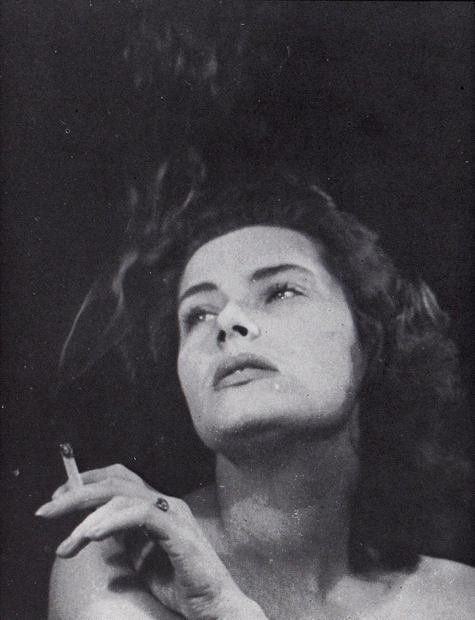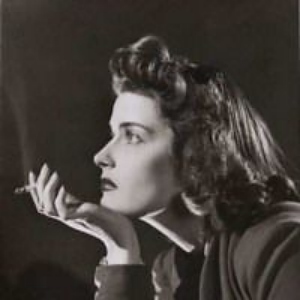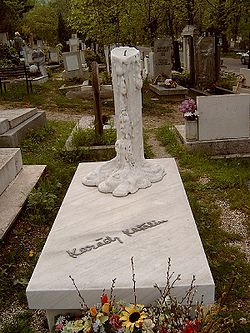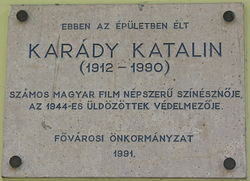Katalin Karády
A sex symbol and a legend
Most nations have a history, Hungarians have Fate. If you want first-hand experience of what this means, go to YouTube and listen to Katalin Karády’s melancholy chanson ‘Smouldering cigarette end’ (Hamvadó cigarettavég). A low decadent voice full of eroticism, a woman in her late twenties with a seductive appearance, who sent men crazy and even made well-brought up ladies become maniacal followers of fashion. The male victims of this femme fatale included a taxation officer thirty years older than herself who became her first and only husband. Her real great love was the Gestapo’s top wanted person and the head of Hungarian military intelligence during World War II.
Born in 1910 as the seventh child of a messy working-class family, her first and utmost ambition was to get out of poverty and her terror of her father, a compulsive gambler on the horses. His name, Kanczler. was too German-sounding for a media career in Hungary and it was her lucky star, Zoltán Egyed, an influential journalist, who “invented” her as an actress and who later became her impresario. In 1938 he suggested she Hungarianize her name to Karády; he created her image as an actress. After a mediocre debut on stage she burst onto the film scene a year later becoming a celebrity almost overnight with the film “Deadly Spring” (Halálos tavasz), not a film of particular artistic value, one of a dozen the Budapest film studios produced in assembly line fashion. The film went almost unnoticed, but thanks to the very influential Catholic Church it became a box-office hit. What inspired the clerics to brand it immoral and detrimental to Christian young people and family values was the not so subtle eroticism Karády produced.
The defenders of pure morals were right in this case. Like Marilyn Monroe, she broke sexual taboos. Contrary to the typical female film figures of the day she appeared not as a dumb, sentimental character but a flesh and blood seducer, smoking a cigarette and even wearing trousers. She immediately created fashion, her hairstyle was imitated by hundreds of thousands, her hats became extremely trendy and Karády Fan Clubs were set up all over the country, their members recognized by the Karády collar on their dress.
In the following six years she starred in 22 Hungarian Hollywood-style films and her popularity lasted until the end of the war. She was the leading singing star of the era. Her songs abounded in terms related to fate (“that caused the fall for both of us;” “you can’t escape your fate” etc.). The song “Somewhere in Russia” was a sad lyrical memento to the Hungarian soldiers who perished on Russian soil. The style and effect of the song is reminiscent of the similar one during the war by Marlene Dietrich.
What was the secret of her six-year fame? She began her career in 1939 just when Poland was crushed and Hungary opened its borders to hundreds of thousands of Polish refugees. The Hungarian elite was too complacent and short-sighted to foresee that only six years later the price for siding with Hitler would be a country devastated and again truncated, with enormous loss of life. Hungarians were starving for someone to express the Zeitgeist of the era: doom, yielding to Fate, apathy and fear of what may come.
Her career came to an end abruptly after the German occupation of the country in 1944 when the Gestapo held her for months, interrogating her about her connections with pro-Ally contacts, especially István Újszászy, Admiral Horthy’s close associate and head of military intelligence. Unlike her brief marriage and countless love affairs her relationship with Újszászy, a most intelligent and handsome man, was not only passionate but fatal as well. He was arrested the same day as Karády, and later released only to be captured by the Russian army eight months later. She never recovered from the loss of her fiancé. She used her contact with Újszászy to save Jews by organizing their release and hiding them in her villas, of which she had many. In 2004 the Israeli Government awarded her the title of Righteous Person.
After the war she was neglected as an actress. The new communist elite saw her as the representative of a bygone era. Not finding her role under the new regime she decided to flee the country in 1951, leaving everything behind including relatives who were persecuted because of her defection. She settled in Brazil, as at the height of Cold War hysteria in the US she was not granted an American visa. Only 17 years later was she allowed to settle in New York where she ran a fashionable hat shop and lived as a recluse until her death in 1990. She was adamant that she should maintain her legend and never allowed herself to be photographed. Even when her nostalgic revival was at its height in Hungary in the 1980s she still refused to return to Hungary.
But the nation held on to its myths, she was the one thing worth remembering from the war. Eleven days after her death in New York her coffin arrived in Budapest and was displayed in St.Stephen’s Basilica. Tens of thousands attended her solemn funeral which reminded people of her famous lines:
Don’t ask who I was
I’ve asked for my fate,
So when it’s all enough
I’ll be saying adieu.
You can read more of famous Hungarians in the author’s book available at AMAZON:



